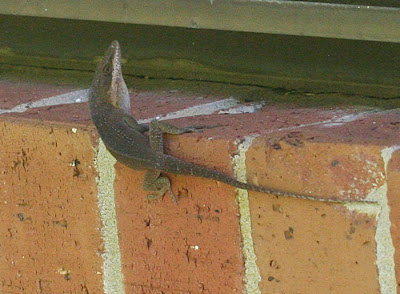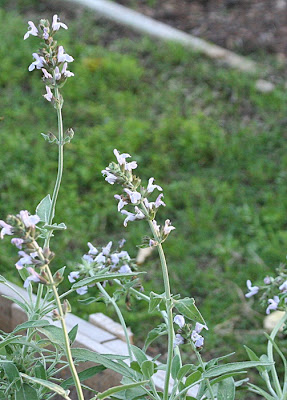This one has staked out a crape myrtle tree. I see him patrolling its limbs and displaying his throat pouch for any female who may be watching every day as I sit nearby.
This guy claims the redbud tree as his territory.
He's saying, "Look at me! Isn't my red throat pouch the most handsome thing you've ever seen?"
He may look like a brown anole but he's really green. He's just camouflaging himself to blend in with the dark bricks.
It was a week of firsts in the garden.
The first clematis ('Rouge cardinal') blossom opened.
As did the first pomegranate blossom.
There are lots more on the way.
The first daylily opened yesterday.
Today a second variety, also yellow, opened its first bloom.
The first blossom on the 'Fuji' apple tree that I got to replace my old apple tree that died also opened this week.
Nearby, my little Satsuma tree was covered in blossoms. Last year it had a few blossoms and set some fruit but all of the fruit fell off while it was still small. I'm hoping for better luck this year.
Yesterday I showed you the Monarch butterfly that visited and left her eggs on my milkweed.
Well, today, another female showed up and she, too, was busily laying eggs on the plants.
Later, I checked the leaves of the plants and found these little white eggs on many of them.
But it is not just Monarchs that are thinking about the next generation. Recently, I got a small spicebush and planted it in my garden. My main reason for getting it was that it is the host plant for the Spicebush Swallowtail butterfly and I generally have several of those butterflies in my yard in spring and summer. Today, I saw a black butterfly hovering around the spicebush and picked up my binoculars to get a closer look. Sure enough! It was a very tattered Spicebush Swallowtail and she was laying her eggs on my little bush!
Again, I checked the bush later and found six of the butterfly's eggs on its leaves. There may have been others that I didn't find. I think I may need to purchase another of the plants. The bush is so small and its leaves not fully developed yet, I'm not sure that it can sustain a population of caterpillars.
This esperanza lives in the protected south-facing corner of the "L" of my house. It never died back all winter and, in fact, it carried a few blooms right through the winter months. Now it is putting on even more blooms.
Three happy-faced gerberas form a natural bouquet.
Even the culinary sage in the vegetable and herb garden is sporting a plethora of these pretty blooms.
The unsinkable 'Peggy Martin' rose is beginning its bloom. This is the famous rose that survived a long period under very nasty water in a garden in New Orleans after Katrina hit. Weeks after the storm, once all the water had drained away, the rose bloomed again. Nature is an amazing thing.
In the corner of the wildflower bed, the bluebonnets - and pink bonnets - are in bloom now.
And the first amaryllis of the season is almost there.
And up on the Squirrel Highway, the utility cable over the back of the yard, one of the local squirrels watches over it all and wonders where the snacks are.





















So many beautiful blooms. I have been waiting to see some bluebonnets from Texas! Last year I put in a Passionvine and the Gulf Fritillary found it very quickly. I too was concerned about it supporting the four caterpillars that hatched. It is amazing how quickly the butterflies find the new plants. Love the anoles...they are so fun to watch!
ReplyDeleteAnoles are among my favorite garden critters. It is a good year for bluebonnets, Karin, after a couple of not-so-good years. The roadsides and meadows have turned a heavenly blue.
DeleteNice pictures. I really like the red of that Clematis.
ReplyDeleteThanks, ossnap. I'm quite fond of that clematis myself. This is the third year it has been in my garden and so far it has been a winner.
DeleteDorothy, you are such an inspiration to me!! We have just awarded you with the Liebster Blogger Award. Please check the following link to accept your award. http://thymesquaregarden.blogspot.com/2012/03/liebster-blogger-award-goes-to-tsg.html
ReplyDelete~ Pammy
How lovely! Thank you for thinking of me, Pammy. I understand that I need to select five recipients of this award. There are so many bloggers who inspire me, I'll have to think long and hard.
DeleteI used to see anoles all the time at a house I lived in many years ago, over in West Houston. For some reason, I see very few of them now, since I've been up in this area. I love all the blooms you have in your garden, and envy you your butterfly eggs. I've seen monarchs, but haven't see eggs yet.
ReplyDeleteThe anole population has exploded in my yard in recent years, Jayne. Your garden is a lot newer than mine and I suspect you'll begin to see more and more there in coming years.
Delete